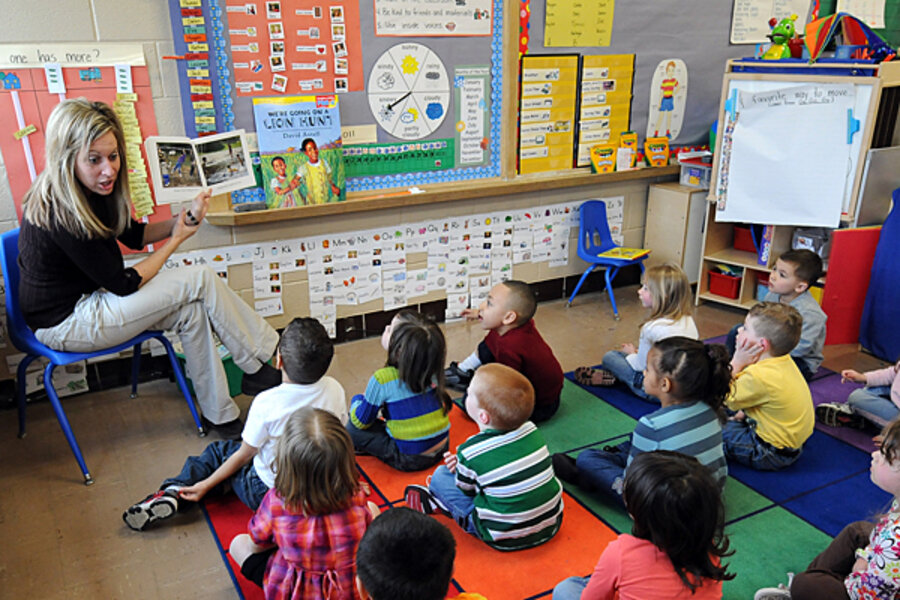Preschool programs not spared as strapped states cut spending
Loading...
For the first time since 2002, states collectively decreased spending on early childhood education last school year, meaning fewer preschoolers were admitted to subsidized programs in some states. Those findings, from a study released Tuesday, also said the cuts would have been more severe if not for federal stimulus money, as most states cut services to grapple with budget gaps.
Overall per-pupil spending in preschools dipped to $4,028 last year – $114 lower than the previous year, and nearly $700 below the 2001-2002 level, according to "The State of Preschool 2010," issued by National Institute for Early Education Research (NIEER). Though three states boosted preschool funding by more than 10 percent and two states – Alaska and Rhode Island – added preschool programs, such investment was the exception rather than the rule last year.
The findings come even as Congress considers proposals for steep cuts to Head Start and other early education programs. The NIEER study argues that state-funded preschools – many of which serve low-income families – are resource-strapped and deserve more funding rather than less, because of the long-term payoff in fewer dropouts, fewer teen parents, and a reduced criminal activity as teens or adults. It also backed the Obama administration’s proposal for an Early Learning Challenge Fund to encourage state spending on preschools.
In all, state funding for preschools dropped by nearly $30 million last year, the study showed. Nine states cut more than 10 percent of their preschools’ funding, 10 states have no state-funded preschools whatsoever, and – of the 40 states with preschool programs – 19 have reduced per-pupil spending.
This dip in preschool funding makes it difficult to improve the quality of early childhood education, which the study says is already low. Five states (Alaska, Alabama, North Carolina, Louisiana, and Rhode Island) have preschool programs that met all 10 of NIEER’s quality benchmarks regarding teacher credentials, class sizes, and other factors believed to influence the classroom experience.
“The funding situation for pre-K may get worse even as the economy slowly recovers,” the study authors write. “Federal funds to help states weather the recession are now gone.”
The federal government spent $49.3 million to subsidize state-funded preschools last year, yet these programs have fewer resources than before, because of cutbacks in local support.
“At just the point where parents [can least afford] to provide for their children’s early development, the state has pulled the rug out from under them,” says study author W. Steven Barnett.
Mr. Barnett argues that the need for state-funded early education has increased as spending has dropped. Because of the economic downturn, 25 to 30 percent more families qualified last year for subsidized pre-K last year, he says.
However, Barnett says, because of a mismatch between resources and demand, state-funded preschools have turned away needy students – a phenomenon that explains why preschool enrollment increased by only 1 percent in 2010. Some 1.3 million young children attended state-funded preschool programs; they make up 14 percent of 3-year-old preschoolers and 40 percent of all 4-year-old preschoolers.
US Education Secretary Arne Duncan calls the study results “discouraging” and urges state lawmakers to spend more on preschools to ensure that they amount to more than “glorified babysitting.” Otherwise, he says, many children will not be adequately prepared to enter school.
“We have to get out of the catch-up game in education,” Mr. Duncan says, warning that helping students who start off behind is a formidable challenge.
Research has consistently shown that pre-K programs improve educational outcomes, particularly for disadvantaged youths. Hence, Duncan argues, reducing preschool funding is shortsighted, and he says he will be campaigning to persuade governors to safeguard preschool programs.
“Budgets always reflect our values,” he says. “When budgets are tough, we have to make painful choices. But surely there is a better, less damaging option" than cutting preschool funding.
In Ohio, one state that cut its early education contribution, the budgetary realities have proved to be difficult to overcome. "What we have tried to do is adjust the dollar amount per student so we could accommodate more students," Patrick Galloway, spokesman for the Ohio Department of Education, told the Columbus Dispatch. The cuts were painful but necessary given the shortfall in Ohio's state budget, he said. "All in all it's a budget decision. Until we can see a way to provide additional funding to these kinds of programs, we'll just do what we can."
Barnett urges a more long-range view. “As America falls behind in the early education of our children, we also fall behind in school success and economic competitiveness,” he says. “As we exit the current recession, America will make critical decisions about how much we are willing to invest in our children’s future. Decisions about state pre-K will be among the most important.”





